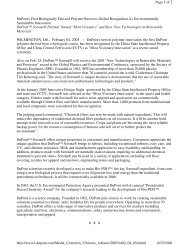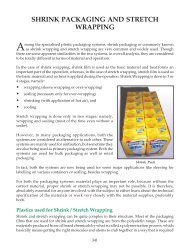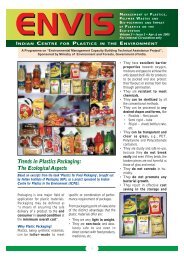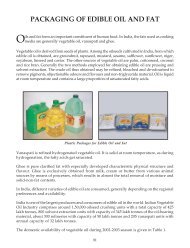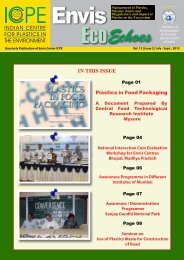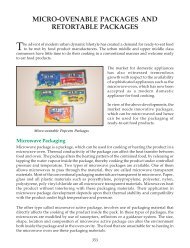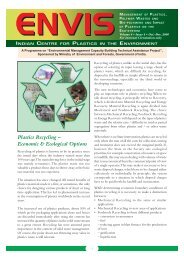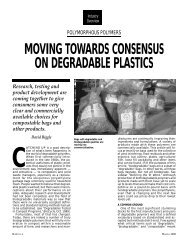packaging of ready-to-eat/ready-to- cook food - Indian Centre for ...
packaging of ready-to-eat/ready-to- cook food - Indian Centre for ...
packaging of ready-to-eat/ready-to- cook food - Indian Centre for ...
You also want an ePaper? Increase the reach of your titles
YUMPU automatically turns print PDFs into web optimized ePapers that Google loves.
For freshly baked products such as bread, cake, ERH is <strong>of</strong>ten higher than the ambient ERH.<br />
There<strong>for</strong>e the products tend <strong>to</strong> br<strong>eat</strong>he out the moisture and if excess water vapour is not allowed<br />
<strong>to</strong> escape from the closed package, condensation on the outer surface <strong>of</strong> the product occurs,<br />
spoiling the product quality and leading <strong>to</strong> mould / yeast growth. Plastic films such as low<br />
density polyethylene (LDPE), which are permeable <strong>to</strong> water vapour are normally used <strong>for</strong><br />
<strong>packaging</strong> these products <strong>for</strong> shorter shelf-life.<br />
For longer shelf-life, microbial spoilage is the main consideration. The products are sterilized<br />
and packed in hermetically sealed containers such as cans, re<strong>to</strong>rt pouches or aseptic packs.<br />
Medium and high moisture <strong>food</strong> are very susceptible <strong>to</strong> the microbial spoilage and need adequate<br />
processing and preservation methods, prior <strong>to</strong> their <strong>packaging</strong>.<br />
Oxygen /Air Permeability<br />
RTC <strong>food</strong> normally contain fat as well as other ingredients that can be oxidised. If oxygen/<br />
air is allowed <strong>to</strong> come in contact with the packaged <strong>food</strong>, oxidative degradation <strong>of</strong> fat<br />
occurs, and many other oxidative changes take place, which cause rancidity, <strong>of</strong>f flavour<br />
and discolouration in the <strong>food</strong>. Hence, <strong>packaging</strong> material <strong>for</strong> high fat should have low<br />
oxygen permeability.<br />
Nitrogen Permeability<br />
To protect the <strong>food</strong> from oxygen/moisture, the <strong>food</strong> is usually packed in an inert atmosphere<br />
<strong>of</strong> Nitrogen ( N 2 ). The N 2 permeability <strong>of</strong> the package should be low <strong>to</strong> prevent its escape in<strong>to</strong><br />
the atmosphere.<br />
Grease Resistance Properties<br />
A variety <strong>of</strong> RTC <strong>food</strong> have edible oil and fat as their ingredients. Fat/oil during s<strong>to</strong>rage<br />
should not adversely affect the <strong>packaging</strong> material used <strong>for</strong> these products, as fat may ooze<br />
out.<br />
HDPE and LDPE are affected by fat and are not suitable <strong>for</strong> packing fatty products. Polyester<br />
films, cellophane, polypropylene, inomer films etc. are suitable <strong>for</strong> such applications. If made<br />
in laminates, then the film <strong>of</strong>fering excellent grease resistance is used as the innermost liner <strong>of</strong><br />
the laminate.<br />
Flavour and essential oils contribute <strong>to</strong> the organoleptic qualities <strong>of</strong> many RTC <strong>food</strong>. They are<br />
volatile substances and hence gas permeability <strong>of</strong> the <strong>packaging</strong> material should be very low<br />
<strong>to</strong> prevent flavour loss. This is also necessary <strong>to</strong> block the entry <strong>of</strong> the outside oxygen and air,<br />
which could bring out the oxidative changes in flavour.<br />
Light Sensitivity<br />
Light accelerates oxidative changes associated with the flavours and fats in <strong>food</strong>. Opaque<br />
<strong>packaging</strong> materials such as cans and aluminium foil <strong>of</strong>fer best protection from light.<br />
Metallised polyester and pigmented plastics are found quite satisfac<strong>to</strong>ry. Light could cause<br />
discolouration in coloured <strong>food</strong>. Some films are opaque <strong>to</strong> visible light but allow U.V. light<br />
<strong>to</strong> penetrate.<br />
156



